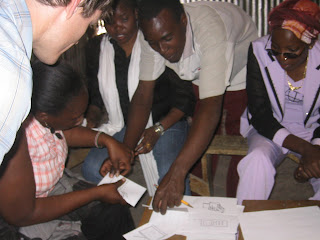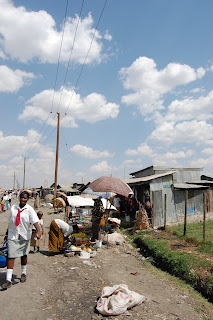We had five really packed days and one day relaxing with giraffe in Nairobi. We interviewed about half dozen local architects and had about half dozen other meetings ranging from US officials that do AIDS related work at the
USAID offices housed at the embassy to documentary filmmakers from Austin, TX at an Ethiopian restaurant. The local architects we met with were highly qualified and ran quite a range from a top 10 firm in Africa that had designed many of the skyscrapers in Nairobi to an American who has been working in East Africa for 15 years doing primarily charity type work to a young firm with 2 ½ years experience that also teaches at the University of Nairobi and collaborates with a
Herzog and
de Meuron studio from the Basel school of architecture, as well as with Harvard’s Graduate School of Design working in
Kibera slum. We will be selecting the firm we will be working with by next week. It will truly be a tough choice, but at least we have three excellent options and feel confident that our design will be in good hands. We are scheduled to make a return trip in the middle of October to move the schematic design toward completion.
 http://www.openarchitecturenetwork.org/sidarec
http://www.openarchitecturenetwork.org/sidarec is home to our project on the Open Architecture Network where we will be updating our design as it progresses. So stay tuned.
 Ashley, Eric, Geoff, Stephanie and Matthew at Planning Systems Office in Nairobi
Ashley, Eric, Geoff, Stephanie and Matthew at Planning Systems Office in Nairobi Geoff and Matthew discussing drainage issues with Gordon Schofield (Mechanical & Electrical Engineer) and Eric Kigada (Architect at Planning Systems)
Geoff and Matthew discussing drainage issues with Gordon Schofield (Mechanical & Electrical Engineer) and Eric Kigada (Architect at Planning Systems) Entrance to Planning Systems Office, Nairobi
Entrance to Planning Systems Office, Nairobi













 A typical vendor's produce stand along the road to the Mukuru site.
A typical vendor's produce stand along the road to the Mukuru site. Although a predominantly Christian nation, Kenya has a significant Muslim population due to its history of its coastal access by Arab traders. Much of Mukuru's new population are immigrants and refugees from Somalia.
Although a predominantly Christian nation, Kenya has a significant Muslim population due to its history of its coastal access by Arab traders. Much of Mukuru's new population are immigrants and refugees from Somalia.






 The radio tower at the Pumwani community center broadcasting Ghetto FM.
The radio tower at the Pumwani community center broadcasting Ghetto FM. Kids at the community center.
Kids at the community center.
























